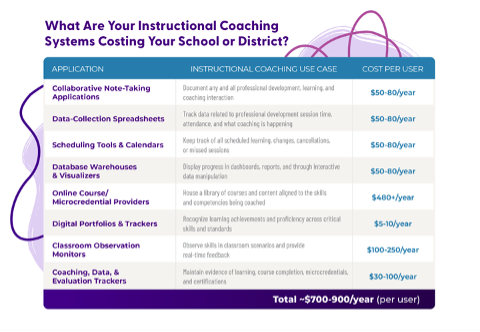Principals’ plates are undoubtedly overflowing. From ensuring smooth daily operations to spearheading strategic initiatives, their responsibilities are diverse and demanding. Amidst these numerous duties, focusing on effectively supporting instructional coaching and teacher professional development can seem daunting, if not impossible.
Yet, effective coaching is critical to foster a supportive and successful learning environment for teachers and students.
Coaching is also supported by a number of studies on the effective actions that lead to positive student and teacher outcomes. A study in 2018 underscored the significant impact of instructional coaching on teacher development and student achievement. The research found that teachers who received coaching demonstrated improved instructional practices, which translated into notable gains in student achievement.
Leveraging Technology to Reduce Stress
To truly transform coaching for teachers and students there needs to be an effective use of technology to manage the coaching experience. This fact was supported by a recent nationwide study of full-time, K– 12 public school instructional coaches who, when asked “what, if any, additional resources, tools do you need to aid your job?” cited:
“…better tools for tracking the attendance of the teachers…”
and
“a single software for all the services…”
Over the past few years, schools have seen an unprecedented increase in the use of edtech, adding to the workload and stress of teachers and staff. Instructional coaches are no different, often grappling with the complexity of utilizing up to eight separate tools and software applications, each serving a different purpose, in their quest to deliver effective coaching.
Fiscal Responsibilities and ESSER Funding
With the coming ESSER federal funding deadlines, public school leaders are also aware of the challenges the next few budget cycles will present. While there is still an enormous opportunity to address learning loss through innovative professional development practices it must be done through fiscally responsible decisions.
One way for school leaders to address the impending fiscal cliff is to turn a critical eye toward reducing the number of redundant technology tools in place. To support coaches in particular, this would result in a solution that unifies the multiple, partially-effective systems into one elegant system.

So, how can school principals streamline instructional coaching systems without it becoming another burden on a leader’s already heavy shoulders, while at the same time avoiding undue technology stress on teachers and staff, while also maintaining fiscal responsibility?
Consolidating Instructional Coaching Systems
A unified platform can bring together multiple functions of instructional coaching and professional development to create a complete, coherent picture. This could bring an array of benefits revolutionizing coaching and, in turn, improve teacher retention, support, and student academic outcomes. Here’s how:
- Simplifying multiple platforms into ONE creates efficiencies and ease of use for principals, coaches, and coachees.
- Having all data in one place allows for improved integrations and data analysis with the added benefit of reducing privacy compliance issues.
- Consistent and timely communication is streamlined into one system.
- A digital portfolio within the platform enables everyone to document their professional growth, including earned badges and microcredentials, fostering career advancement. Principals can use these portfolios to better monitor their teachers’ career trajectories and preparedness, and guide them accordingly.
- Consolidating systems allows for efficient planning and execution of teacher observations and evaluations. This systematic approach can inform coaching strategies, helping to provide more targeted and effective support to teachers and staff.
- Instead of investing in multiple platforms, a single, comprehensive platform can be a more cost-effective solution. The saved resources can be redirected toward other areas of need within the school.
Replacing multiple applications with a unified platform isn’t just about improving the technical aspects of instructional coaching. It’s about creating an environment where teachers feel supported and valued, where they have the tools and resources they need to succeed. It’s about fostering a school culture that values growth, collaboration, and efficiency.
GroweLab, the all-in-one talent development and instructional coaching platform, is the definitive solution to replace multiple, partially-effective systems that are draining funds. By integrating a comprehensive instructional coaching platform, school leaders are taking a bold step towards a more streamlined, effective, and supportive school environment. It’s a step to enhance teacher satisfaction and retention, and ultimately, drive student academic outcomes. And it’s one that becomes more sustainable when faced with tough decisions at budget time.
Isn’t it time we took inventory of the tools we ask instructional coaches to use?
Sponsored Content Disclaimer:
Sponsored Content in Partnership With NASSP
NASSP allows select groups to share information and thought leadership with our program audiences.

